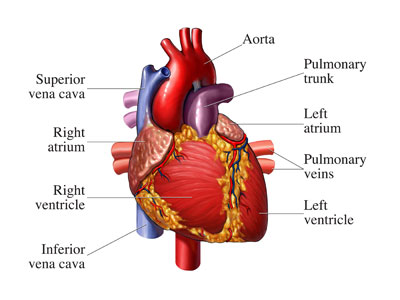Answer the following questions. 2. In what part of the body can arthritis attack joints?
1. What is arthritis?
2. In what part of the body can arthritis attack joints?
3. What are the symptoms of arthritis?
4. What kinds of arthritis do older people have most often?
5. Give the definition of osteoporosis.
6. Where do fractures occur most often?
7. Why is osteoporosis often called a "silent disease"?
8. What does scoliosis cause?
9. When is scoliosis most common?
10.What are the symptoms of scoliosis?
11.What is osteomyelitis?
12.What is the clinical picture of osteomyelitis?
13.Does osteomyelitis require treatment?
The Cardiovascular System.
Серцево-судинна система.
I. Vocabulary.
1. Read and learn the topical vocabulary.
circulatory system — кровоносна система;
heart — серце;
lung — легеня;
artery — артерія;
vein — вена;
capillary — капіляр;
blood — кров;
vessel — судина;
aorta — аорта;
chamber — порожнина;
ventricle — шлуночок;
atrium (pi.atria) — передсердя;
valve — клапан;
tricuspid valve — тристулковий клапан;
mitral valve — мітральний двостулковий клапан;
septum — перегородка.
2. Match the following English word combinations with the Ukrainian ones:
1. blood vessels а) сітка капілярів
2. muscular walls b) коронарні артерії
3. coronary arteries c) кровоносні судини
4. network of capillaries d) вуглекислий газ
5. carbon dioxide e) м'язові стінки
3. Match the terms and their definitions.
| 1. Aorta 2. Artery 3. Atria 4. Blood pressure 5. Vein 6. Ventricles |
a. Vessel that carries blood to the heart.
b. Pressure or force the blood exerts against the inner walls
of the blood vessels.
c. Lower chambers of the heart that contract to pump blood
into the arteries.
d. Main artery of the body.
e. Vessel that carries blood away from the heart.
f. Upper chambers of the heart that receive blood from the
veins.
4. Read and memorize some interesting facts.
• The heart beats about 100,000 times a day, more than 30 million times per year, and about 2.5 billion times in a 70-year lifetime.
• The heart usually beats from 60 to 100 times per minute, but can go much faster when necessary.
• Did you know that the heart in one lifetime will pump approximately 1 million barrels (200,000,000 liters) of blood?
II. Reading.
Read the text closely. Get ready to speak about the structure of the human cardiovascular system.
CIRCULATORY SYSTEM

The circulatory system is composed of the heart and blood vessels, including arteries, veins, and capillaries. Our bodies actually have two circulatory systems: the pulmonary circulation is a short loop from the heart to the lungs and back again, and the systemic circulation (the system we usually think of as our circulatory system) sends blood from the heart to all the other parts of our bodies and back again. The heart is the key organ in the circulatory system.
As a hollow, muscular pump, its main function is to propel blood throughout the body. The heart gets messages from the body that tell it when to pump more or less blood depending on an individual's needs. When we're sleeping, it pumps just enough to provide for the lower amounts of oxygen needed by our bodies at rest. When we're exercising or frightened, the heart pumps faster to increase the delivery of oxygen.
The heart has four chambers that are enclosed by thick, muscular walls. It lies between the lungs and just to the left of the middle of the chest cavity. The bottom part of the heart is divided into two chambers called the right and left ventricles, which pump blood out of the heart. The upper part of the heart is made up of the other two chambers of the heart, the right and left atria. The right and left atria receive the blood entering the heart. The tricuspid valve separates the right atrium from the right ventricle, and the mitral valve separates the left atrium and the left ventricle.
Arteries carry blood away from the heart. They are the thickest blood vessels, with muscular walls that contract to keep the blood moving away from the heart and through the body. In the systemic circulation, oxygen-rich blood is pumped from the heart into the aorta. This huge artery curves up and back from the left ventricle, then heads down in front of the spinal column into the abdomen. Two coronary arteries branch off at the beginning of the aorta and divide into a network of smaller arteries that provide oxygen and nourishment to the muscles of the heart.
Unlike the aorta, the body's other main artery, the pulmonary artery, carries oxygen-poor blood. From the right ventricle, the pulmonary artery divides into right and left branches, on the way to the lungs where blood picks up oxygen.
Veins carry blood back to the heart. They're not as muscular as arteries, but they contain valves that prevent blood from flowing backward. The two largest veins are the superior and inferior vena cava. The terms superior and inferior don't mean that one vein is better than the other, but that they're located above and below the heart.
A network of tiny capillaries connects the arteries and veins. Though tiny, the capillaries are one of the most important parts of the circulatory system because it's through them that nutrients and oxygen are delivered to the cells. In addition, waste products such as carbon dioxide are also removed by the capillaries.
